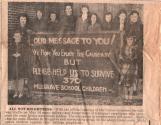9
CONSIDERED DISINCORPORATING -At a July 29th, 1953 Ratepayers Meeting in Port Hawkesbury, the issue of whether a resolution stating that the residents approved an application to the minister of Municipal Affairs to disincorporate the town of Port Hawkesbury and go back to the County of Inverness as a village be submitted. This was due to their concerns about the conditions of their roads and the tax rate and the town's future after the completion of the Canso Causeway.
At the meeting, Dr. Trainor, President of the Board of Trade spoke to the issue as did Mayor Art Langley, and W.V. Mosley, Minister of Municipal Affairs.
Jim Spray said,"...the completion of the Strait of Canso Causeway will determine our status. Either we would forge ahead or perhaps due to the completion of the causeway, our population would decrease and thus we would automatically be declared a village. He bade all to be of good cheer that perhaps good times were in store with a good harbor and a strategic site and industry might start up here and benefit all. He suggested that we stay with the ship and plug the holes". (The Victoria Inverness Bulletin August 5,1953)
The vote was: 72 against disincorporation,14 voted for and one was a spoiled ballot.
11
1953- ARE THEY DOOM TOWNS? - The Canso Causeway May Ruin these Nova Scotia CommunitiesThe Weekend Picture Magazine cover story highlighted the concerns of the people in Mulgrave, Guysborough County on the mainland side of the Strait of Canso, and Point Tupper, Richmond County and Port Hawkesbury, Inverness County on the Cape Breton side.
Their communities would be hard hit after the completion of the Canso Causeway because so many had been employed on the ferries and railroad for over fifty years.
12
Point Tupper Village and Georgia Pacific Gypsum Plant1970
Point Tupper, Richmond County, Nova Scotia, Canada

15
DEDICATED VISIONARY - 1953- Leonard O'Neil, Mayor of Mulgrave, gathered together businessmen and politicians from Antigonish, Guysborough, Inverness, and Richmond Counties to form the Four County Industrial Development Association whose main objective was to bring a pulp and paper mill to the Strait of Canso area. Factors to Consider When Choosing a Mill Site - WOOD, POWER, WATER (24 Million gallons a day),LOCATION (Deep sea and rail shipping available), ON or NEAR PROVINCIAL HIGHWAY, FINANCING AND MANPOWER.
17
LAST CROSSING - The crew of the Scotia II train ferry received their letters stating their services were no longer needed as of May 14th, 1955. A group picture was taken before the last run across the Strait of Canso between Mulgrave and Point Tupper was made.Point Tupper was particularly hard hit as the industry that eventually came to the Strait of Canso area starting in 1959 located in their back yard, and eventually cause their families to be relocated in the 1980's.
Population in 1951 for Port Hawkesbury was 1,034, Mulgrave - 1,212 and Point Tupper -394.
By 2001, Port Hawkesbury was 3701, Mulgrave- 904 and Point Tupper - 12.
20
FORCED TO LEAVE AREA - 1955- Workers like Francis O'Neil who had worked on the Scotia train ferry between Mulgrave and Point Tupper did have to leave his wife and children behind in Mulgrave and go to work at the other end of the province of Nova Scotia. Many others were forced to do the same while many left the community altogether.22
IMPACT ON MULGRAVE BLEAK - Under the newspaper headline, "Progress Forges Ahead, The Old Bows to the New" in May 1955, this picture was beside the one of the last run of the train ferry across the Strait of Canso and the railway vice president at the ribbon cutting ceremony of the first official train to cross the Canso Causeway.The future looked bleak for the families in these small communites who had relied on the ferries and railroad for their livelihood for over fifty years.






